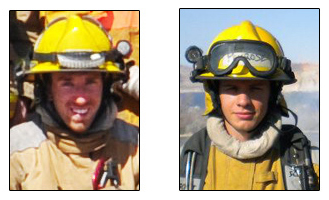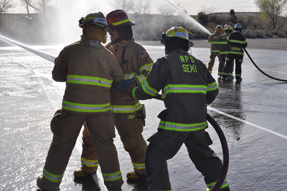This is the last in a series about two structural fire academy candidates, Brandon Penrose and David Robinson, park rangers from Grand Canyon National Park. Their stories have been blended together.
This class allowed me to be confident in myself in handling a hoseline, extinguishing a fire, or directing people to locations with tasks. This class has it all. . . it was two weeks of constant on-the-go activities that ensured that confidence.
Day 10 — Putting It All Together
Today is the last day of structural fire academy and we are training with live fire again. For the first time, I actually got to fight real fire in a containerized setting. It was not what I expected at all, but it was an unforgettable experience. There is nothing quite like entering a building filled with pitch black smoke and not being able to see anything other than flames rolling overhead. The fear of the unknown I felt at the opening of the container was followed by the sheer excitement of blasting overhead flames with water, and then going in for a direct water attack on the seat of the fire.

Setting up to enter the structure with a minuteman hose, I was accompanied by two additional team members. Our instructors start the fire in the structure, make sure it gets up to a point where they see ample fire behavior, and give us the go-ahead to enter the structure. Five feet inside of the structure, the visibility is zero. I can't even see the nozzle in my hands. Trying to stay low, dragging a hose, looking up for fire behavior, and maintaining nozzle control is really difficult when advancing in the structure. At points, our team had to stop and drag the hose around a corner because it would get caught up and delay the attack. I knew I was getting closer to the fire because the heat level was increasing. I could feel the radiant heat. I continued to look up because that is where I would see rollover and the first fire behavior. As I turned the corner I looked up and saw tons of rollover on the ceiling. I shot a short burst of narrow fog at the ceiling, which dropped the fire back. I advanced a few feet further and shot another burst into the ceiling when I saw fire behavior. I was able to see the source of the fire at this point so I went in to attack it. It was extremely hot at this point. As soon as I put water on the base of the fire, the room went completely black. I knew I had PPV (positive pressure ventilation) and I knew there was a window open. I had to find that window with a narrow fog and start to hydraulically vent the building. As soon as I started to vent, the air got cooler, visibility increased and I could see that the fire was still burning. I would go back and hit the fire with water, then rotate back up to hydraulically vent. The process was amazing.
The day concluded with us completing a rehab of the entire fire training grounds and a debriefing from our instructors.
Ah, day 10 and it's finally over. Today was a fun day; we were able to fight a real fire. No instructor assistance other than as safety backups, no teaching, just a building filled with dark black smoke and hot flame at the end.

Reflections on Structural Fire Academy
David Robinson: "I felt true accomplishment after attacking that fire with the help of only teammates and no instructors. The amount of energy, both mental and physical, that it takes to advance into a structure is amazing. But being able to extinguish a fire starting from the beginning is something that should be experienced by everyone. I did not feel ill-prepared because of the other components of the class. This class allowed me to be confident in myself in handling a hoseline, extinguishing a fire, or directing people to locations with tasks. This class has it all, and to think - it was two weeks of constant on-the-go activities that ensured that confidence."
Brandon Penrose: "My final thoughts on the structural fire training academy are overall great. I am not someone that grew up wanting to be a firefighter and drive big fire engines like so many others do. The thought of wanting to run into a burning building actually seemed to be one of the most illogical things a person could ever do. But when the opportunity to come here and train came up, I came for several reasons. The first was to be able to help the other rangers in my district when fire or rescue emergencies really did emerge. The second reason for coming to Glen Canyon for structure fire training was to push myself out of my comfort zone and learn a new skill that I had previously thought that I couldn't have. Being a ranger that could provide a multitude of services has been and will continue to be the goal for me and other rangers servicewide. Our diversity of skills is part of what makes us in the National Park Service so unique."
"The training that you will receive here in my opinion is second to none for catering to the needs of the students both during the training, and in giving you training that you can actually use when you return to your home park. The instructors realize that we are all from small parks and departments, and they give us the skills and confidence to fight fires on the small departments located in our parks. The training is definitely not easy, and anyone who attends will be tired physically and mentally at the end of every day. But this sort of fatigue is normal for the massive amount of skills that you will be gaining over two weeks. Anyone who attends will also get hot, wet, and dirty on a daily basis. I'm not going to kid anyone; the training is tough, but the tasks are not impossible. At the end of the day each firefighter who has put in the time and effort will succeed, and the larger goal of helping ourselves, our coworkers, neighbors, and the public visiting our parks will have been accomplished."
Lead instructor Joe Lachowski: "Towards the end of the two weeks everyone is tired, challenged and wants nothing to do with a minuteman deployment. But when I step back and watch these new firefighters complete evolutions fluidly, safely, and as a crew and realize that two weeks ago some of them had never even put on bunker gear, it is impressive to see how far they have come. This accomplishment speaks to their desire to learn and practice and how the academy emphasizes the basics repeatedly. It really shows in the rapid progression and comprehension of new skills."
Professional standards are extremely important in high-risk occupations such as structural and wildland firefighting, emergency medical services, and law enforcement. On January 20, 2012, the Service's structural fire suppression training program was formally awarded accreditation through the National Board on Fire Service Professional Qualifications, more commonly known as Pro Board. Now when students successfully complete this NPS class, including the prerequisites and taskbook, they will receive certifications that contain both the NPS logo and the Pro Board seal, indicating a nationally recognized quality standard in both training and testing.
Successfully graduating from the firefighter academy is only the beginning of a firefighter's education. Valuable skills and experience will be gained working side by side with their parks' more seasoned firefighters while responding to calls such as burning buildings, vehicle accidents and fires, EMS calls, dumpster fires, HAZMAT, and much more.
Part of a series of articles titled Structural Firefighting Academy.
Previous: Learning the Basics, Part 4
Last updated: December 2, 2016
